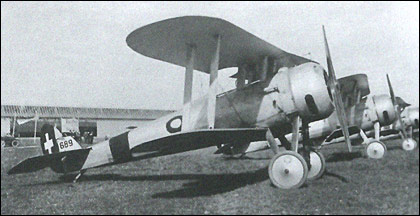|
| There is no text information for this aircraft at the moment.

| veronica, e-mail, 23.08.2016 06:09 I from Argentina and I need help to find the construction plan for Nieuport 28 c1. Can you help me? best regards reply | | Klaatu83, e-mail, 06.07.2013 20:52 The Nieuport 28 wasn't a bad fighter, it simply wasn't as good as the SPAD 13, which was what the French Air Force preferred. The U.S. Air Service accepted the N.28 because, at the time, the French Air Force required all the SPADs that were being produced, and the N.28 was simply the best alternative that was currently available.
The first N.28s were delivered to the USAS without any machine guns. Vickers guns were subsequently fitted, with one machine gun apiece as the weapons became available. later, as additional weapons became available, two machine guns were installed.
The rotary engine used in the N.28 was notoriously unreliable and tended to catch fire if it was operated incorrectly. However, the greatest problems with the N.28 were not caused by any specific design design deficiencies, but simply due to poor construction quality control at the factory. That was what caused the separation of the fabric skin from the wings, for which these airplanes became so notorious. reply | | Barry, 15.02.2013 17:59 Never quite as good as it looked, the Nie 28 was the first Nieuport to do away with the V strut and use parallel struts. Like all previous scouts from the Nie XI, the Nie28 was designed by Gustav Delage and as a matter of course was ordered into production by the French Government. The aircraft was powered by the very unreliable Gnome 9N Monosoupape nine cylinder rotary and had the propensity to tear fabric from the upper wing in a dive. It went through many modifications ordered by the 'Aviation Militaire' but to no real avail. When the AEF turned up it was the one fighter that there was plenty of and to be fair the first Amrican ace Lt Douglas Campbell flew this plane. Fortunately the Spad became available and the "Yanks" were only to happy to take on the new mount. Some found their way back to the U.S.A. and others were sold to the Greeks and the Swiss.
Dimensions: Span 26'8" (8.15m) Length 21' (6.4m) Height 8'2".
Weights: Empty 1,047lb Loaded 1,625lb
Performance: Max speed 122mph Initial climb 1,640' /min Service ceiling 17,000' Range 155 miles
Armament: Two fixed syncronised Vickers 0.303 in machine guns American models used 0.30in Marlin reply | | David, e-mail, 01.06.2012 14:27 Definitely one of the all time classics! A beautiful aircraft. reply | |
| | David, e-mail, 01.06.2012 14:26 Definitely one of the all time classics! A beautiful aircraft. reply | | napo, 18.06.2011 08:47 The model is different in that I used Eddie Rickenbackers scheme that is no 12 and has a white cowl plus different wheel colors. reply | | Fred Meyer, e-mail, 01.12.2010 00:29 I have built a model of this aircraft from a Proctor kit. The model is different in that I used Eddie Rickenbackers scheme that is no 12 and has a white cowl plus different wheel colors. The model flies excellent with a 36cc 4 cycle gas motor. Best looking WWI fighter. reply |
|
Do you have any comments?
|
| 
All the World's Rotorcraft |













